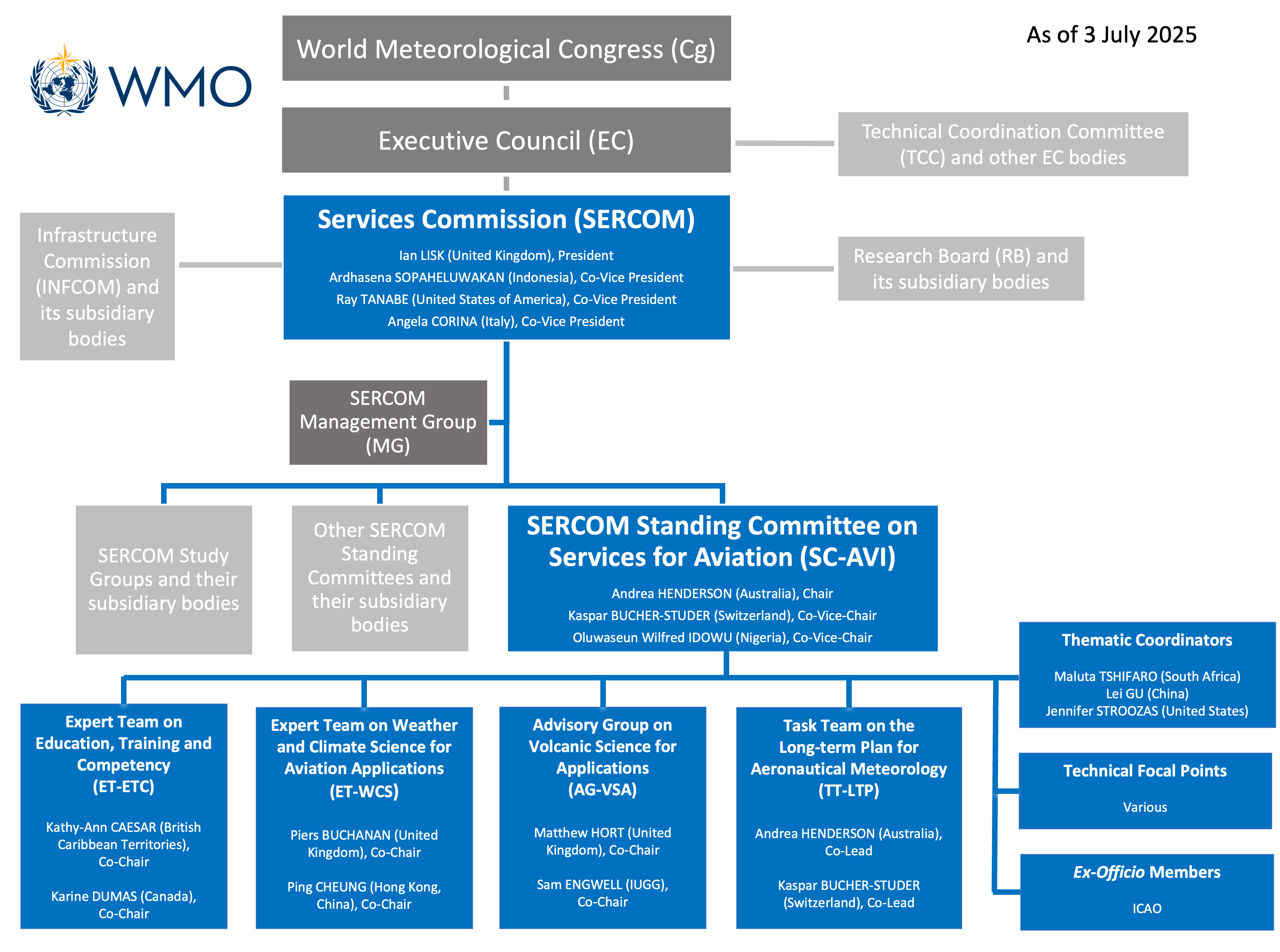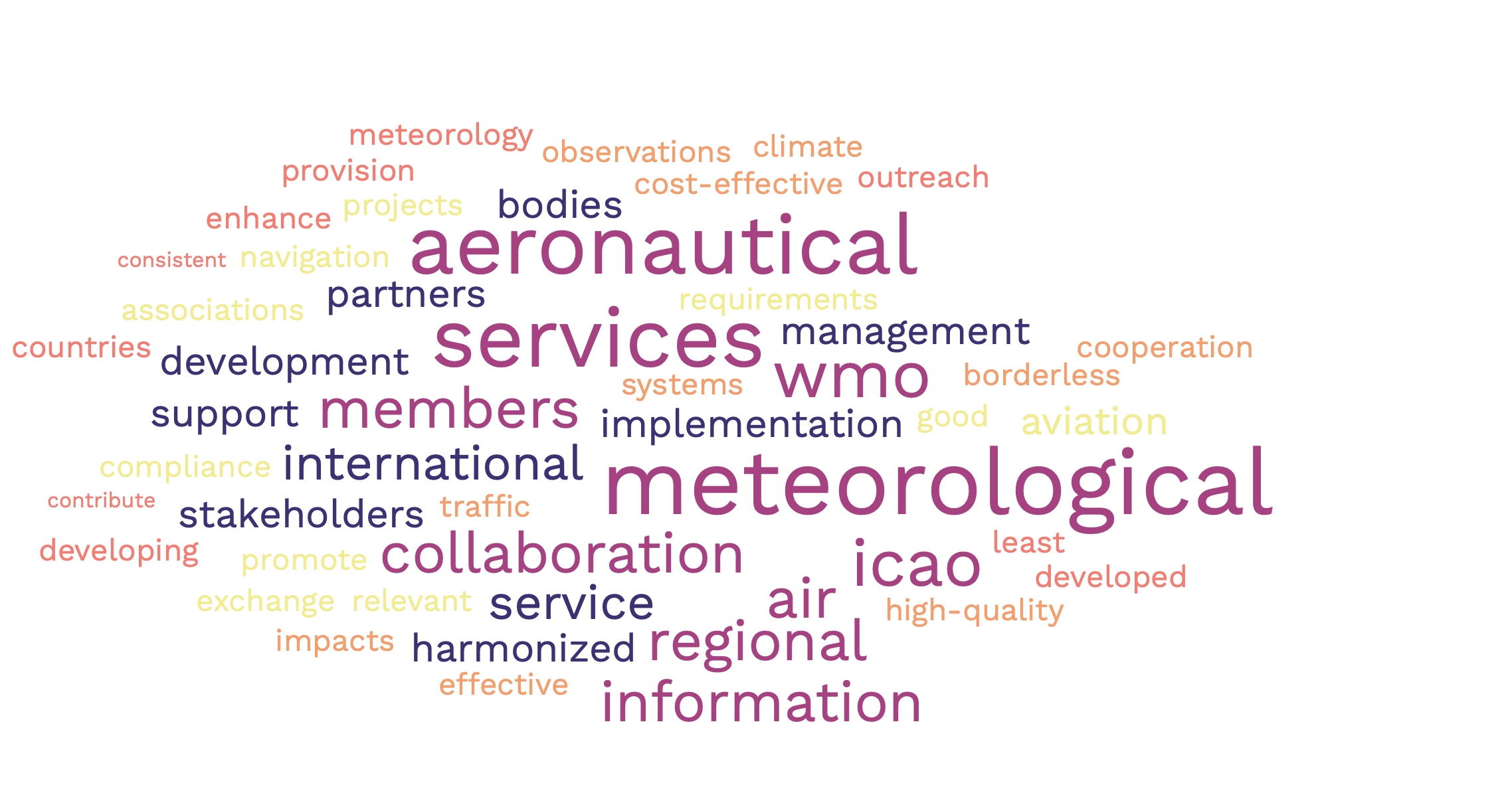Standing Committee on Services for Aviation (SC-AVI)

Jump to: Background | Governance | Purpose | Expertise | Membership | Duration and Modalities of Work | Outputs | Reports | Subsidiary Bodies | FileCloud Collaboration Platform
Background
In 2020, through Resolution 1 (SERCOM-1), the Commission for Weather, Climate, Hydrological, Marine and Related Environmental Services and Applications (the 'Services Commission' or SERCOM) established, inter alia, a Standing Committee on Services for Aviation (SC-AVI) for the period 2020 to 2023.
In 2024, through Resolution 3 (SERCOM-3), the Services Commission re-established SC-AVI for the period 2024 to 2027 with the terms of reference as given below.
Governance
The SC-AVI is a subsidiary body of the Services Commission (SERCOM) and, accordingly, reports to SERCOM on a routine basis. Information on SERCOM is available here.
The SC-AVI itself comprises several subsidiary bodies in the form of expert teams (ETs), an advisory group (AG) and a task team (TT). Details on the nature, composition, activities and deliverables of the SC-AVI subsidiary bodies is available here.
The organizational chart for SC-AVI is as follows (click here open/enlarge in a new window):

The following sections provide information on the purpose, expertise, membership, duration, modalities of work and outputs of SC-AVI. In addition, access to the reports of SC-AVI is provided.
Any questions pertaining to SC-AVI, its parent or subsidiary bodies can be directed to the WMO Secretariat via email.
Purpose
(a) To contribute to advancing the international standardization of meteorological services for international air navigation and to the provision of assistance to Members with aeronautical meteorological services to achieve compliance with those standards.
(b) To promote and facilitate the international sharing of implementation experience and good practice, the uptake and exchange of scientific and technological advancements, including pilot projects where appropriate, to meet evolving user requirements for high-quality, seamless, harmonized and cost-effective aeronautical meteorological information and services.
(c) To analyse the impacts of evolving technology, climate change and variability (including extreme weather and climate-related events), environmental sustainability targets, advances in scientific applications, and evolving international regulations on the provision of aeronautical meteorological services, and communicate these impacts to Members and aviation stakeholders concerned in a meaningful and proactive manner.
(d) To contribute to the long-term planning and development of enhanced aeronautical meteorological information and services in support of the future globally interoperable, harmonized air traffic management system.
(e) To promote the integration of meteorological information, i.e. observations, forecasts, warnings and alerts, into air traffic management systems and decision-making, including the transfer of new capabilities into operational and impact-based information services enabled by the science-for-services value cycle and projects such as an Aviation Research and Development Project (AvRDP).
(f) To sustain efficient and effective governance of aeronautical meteorological service provision by Members through the development and/or enhancement of guidance on appropriate cost recovery mechanisms for national and multinational services as well as advice on information and data exchange policies and good practices.
(g) To develop guidance, training material and other educational resources to assist Members in the implementation of the International Civil Aviation Organization (ICAO)/WMO requirements for quality management systems and compliance with the competency and qualification requirements of personnel providing meteorological service for international air navigation, with an emphasis on developing countries, least developed countries and small island developing States.
(h) To respond to Members’ aeronautical meteorology prioritized needs and support capacity development activities aiming to enhance the delivery of fit-for-purpose, high-quality, seamless, harmonized and cost-effective aeronautical meteorological services, particularly in developing countries, least developed countries and small island developing States.
(i) To enhance, through effective communication and outreach, global and regional collaboration and partnership in aeronautical meteorology amongst Members and their aeronautical service providers, aviation stakeholders and other partners, thereby helping to maintain an international community of practice.
(j) To provide advice, upon request, to the Infrastructure Commission (INFCOM) and its subsidiary bodies on the needs and requirements for enhanced observations, especially on the benefits of aircraft-based meteorological observations, including those derived through the WMO Aircraft Meteorological Data Relay programme, to improve services for aviation.
Notes:
- The foregoing (a) to (j) will be addressed by the Standing Committee in close coordination, as and where necessary, with Members, RAs, technical commissions and/or the Research Board (and subsidiary bodies thereof) as well as ICAO and other partners.
- In the fulfilment of its mandate, the Standing Committee will remain cognisant of, as a minimum, the WMO Strategic Plan, the WMO Strategy for Service Delivery and its Implementation Plan (WMO-No. 1129) and the WMO Gender Action Plan.

Expertise
- Meteorology and related sciences including climatology.
- Volcanology and related sciences including geophysics and geodesy.
- Space physics and aeronomy including space weather.
- Meteorological and other environmental hazards, such as releases of radioactive material and other toxic chemicals, with impacts on aviation.
- Aeronautical meteorology service delivery including observations/reports, forecasts, warnings/alerts and advisories.
- Cost recovery and governance of aeronautical meteorological services.
- National and international civil aviation regulations.
- Aviation operations (ground and air) and associated aviation user requirements.
- Observing and forecasting systems design and operation, including but not limited to weather radar and meteorological satellite remote-sensing, nowcasting and short-range prediction, plus training thereon.
- Meteorological codes and data representation.
- Information management and information exchange systems.
- Artificial intelligence and machine learning technologies.
- Quality management systems and (aviation) safety management systems.
- Education and training, competency and qualification of personnel.
- Communications and outreach.
Membership
Membership:
- Andrea HENDERSON, Australia [Chair of SC-AVI and Co-Lead of TT-LTP]
- Kaspar BUCHER-STUDER, Switzerland [Co-Vice-Chair of SC-AVI and Co-Lead of TT-LTP]
- Oluwaseun Wilfred IDOWU, Nigeria [Co-Vice-Chair of SC-AVI]
- Kathy-Ann CAESAR, British Caribbean Territories [Co-Chair of ET-ETC]
- Karine DUMAS, Canada [Co-Chair of ET-ETC]
- Piers BUCHANAN, United Kingdom [Co-Chair of ET-WCS]
- Ping CHEUNG, Hong Kong, China [Co-Chair of ET-WCS]
- Matthew HORT, United Kingdom [Co-Chair of AG-VSA]
- Samantha ENGWELL, IUGG [Co-Chair of AG-VSA]
- Maluta TSHIFARO, South Africa [RA I Focal Point]
- Lei GU, China [RA II Focal Point]
- Jennifer STROOZAS, United States of America [RA IV Focal Point]
- ICAO representatives (ex-officio)
Observers:
- Other technical experts may be invited, based on need, to serve as Observers on the Standing Committee, as determined by the Chair/co-vice-chairs of the Standing Committee in consultation with the president of SERCOM.
Notes:
- To the extent practicable, the composition of SC-AVI should appropriately reflect regional and gender balance.
- Such other technical experts may include representatives of partner international organizations.
Duration
Until the next ordinary session of SERCOM that comes after an ordinary session of the World Meteorological Congress where, if required, the Standing Committee can be re-established at the discretion of SERCOM
Modalities of Work
- Meetings
- Conference calls
- Correspondence including email exchanges and other appropriate online interactions
Reporting Requirements
When requested, the Standing Committee shall, through its Chair (or a co-Vice-Chair under authority delegated by the Chair), furnish the SERCOM Management Group with a progress report on the activities, outputs, priorities and risks of SC-AVI, including those that pertain to its subsidiary bodies as necessary, plus any matters that may require the advice or a decision of the SERCOM Management Group, including those that pertain to recommendations to be submitted to or arising from a SERCOM session.
The Standing Committee shall receive progress reports from its subsidiary bodies when required, for example ahead of and in support of an SC-AVI conference call. Such progress report may be expected to cover the activities, outputs and priorities of the subsidiary body concerned plus any matters that may require the advice or a decision of SC-AVI.
Expected outputs
(a) New or updated WMO Technical Regulations and supporting guidance, including Volume I, General Meteorological Standards and Recommended Practices and Volume II, Meteorological Service for International Air Navigation (WMO-No. 49).
Note: In response to Recommendation 5 (CAeM-16), Resolution 27 (Cg-18) and Resolution 12 (Cg-19), SC-AVI is overseeing the discontinuation of WMO-No. 49, Volume II.
(b) Updated education and training Moodle or equivalent platform supporting the implementation of, inter alia, quality management systems, personnel competency and qualification requirements in aeronautical meteorology.
(c) Updated WMO long-term plan for aeronautical meteorology.
(d) New or updated performance metrics, validation methodologies and service delivery good practices for new and enhanced meteorological services for aviation addressing hazardous meteorological conditions (including icing, turbulence and convection) and other phenomena (including volcanic ash, volcanic sulfur dioxide, radioactive material and space weather).
(e) New or updated models of good practice on the cost recovery of aeronautical meteorological service provision, including in respect of national and multinational services.
(f) Input to the updating by INFCOM of the WMO Rolling Review of Requirements and supporting guidance.
(g) Recommendations for scientific research and development and modes of service delivery good practice developed jointly with the Research Board and World Weather Research Programme (WWRP), including through Phase II of the Aviation Research and Development Project (AvRDP2).
(h) Reports on the climatological variations of interest to aviation stakeholders, including aviation hazards, extreme weather and climate-related events, and their impacts on aviation operations.
(i) Input to the implementation of the WMO Gender Action Plan and associated frameworks that seek to increase the involvement of women and to empower women in leadership within the aeronautical meteorology community.
(j) Periodic community newsletters detailing national and international developments, events and activities concerning services for aviation.
Reports
The SC-AVI convenes quarterly conference calls and periodic (biennial) face-to-face meetings. The reports arising from the face-to-face meetings are publicly available here.
Subsidiary bodies
The SC-AVI comprises the following subsidiary bodies:
- Expert Team on Education, Training and Competency (ET-ETC)
- Expert Team on Weather and Climate Science for Aviation Applications (ET-WCS)
- Advisory Group on Volcanic Science for Aviation Applications (AG-VSA)
- Task Team on the Long-term Plan for Aeronautical Meteorology (TT-LTP)
Click on the links above to find our more information about each of these SC-AVI subsidiary bodies.
In addition, SC-AVI is supported by several Regional Focal Points (see above) as well as Technical Focal Points.
FileCloud Collaboration Platform
The SC-AVI FileCloud collaboration platform (member access only) is accessible here.
CLICK HERE to go to the Services for Aviation homepage
